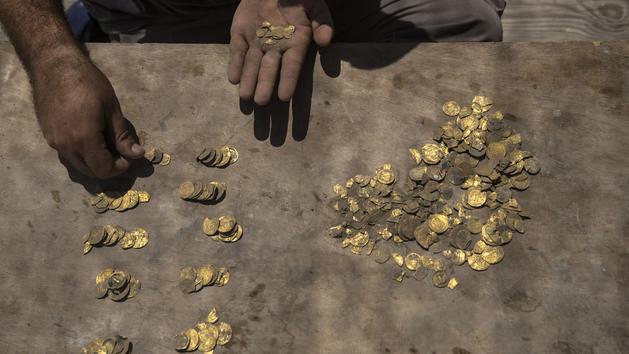A teenager volunteering for an archaeological dig in central Israel has unearthed an exceptional treasure. While digging into the ground, he discovered 425 gold coins dating back to over 1,100 years ago. They were buried and placed in a terracotta jar, in the middle of what was an industrial site under the Byzantine Empire.
Read also: In Israel, the archaeological remains of the oldest and largest city in the Near East unearthed
Most of the pieces date from the beginnings of the Islamic era, when the region belonged to the Abbasid Caliphate. The coins weigh 845 grams and would have been worth a considerable sum at the time they were buried. Enough, for example, to buy a luxurious house in one of the cities of the caliphate.
The identity of the owner of this treasure remains a mystery. HEIDI LEVINE / POOL / AFP
The mystery of the owner
The mystery remains around the identity of the owner of the precious treasure and why he left it there. “ The person who buried this treasure 1,100 years ago expected to recover it. He even locked the container with a screw, ”wrote in a statement Liat Nadav-Ziv and Elie Haddad, the directors of the excavations.
It is very rare to find gold coins, in such large quantities
Liat Nadav-Ziv and Elie Haddad, excavation directorsThe two researchers underline the exceptional character of this find. “ It is very rare to find gold coins in such large quantities. We hardly ever find any during archaeological excavations, gold having always been a valuable material, melted down and reused from generation to generation ”, they explain.
Two of the gold dinars discovered near Tel Aviv. HEIDI LEVINE / POOL / AFP
The young man who discovered the treasure, Oz Cohen, recalls a " fabulous " moment . I dug in the earth and when I searched the ground I saw what looked like very thin leaves. When I looked more closely, I realized that they were gold coins ”.
Robert Kool, an archaeologist specializing in coins, explains that the treasure consisted of gold dinars but also of 270 fragments of coins intended to serve as “ small denominations ”.
He adds that one of the cuts was a fragment of solidus bearing the effigy of the Emperor Theophilus. This coin having been beaten in Constantinople, the treasure provides rare proof of the links which united the Byzantine Empire to the Abbasid caliphate - however rivals - during this period.

